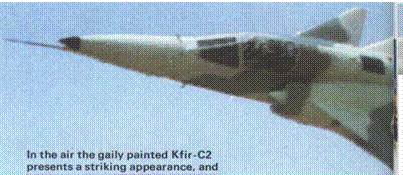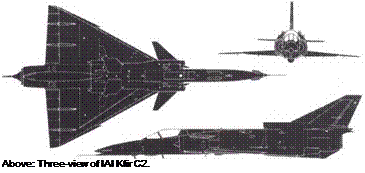IAI Kfir
Kfir and Kf ir-C2
Origin: Israel Aircraft Industries, Israel.
Type: Single-seat fighter bomber.
Engine: One 17,900lb (81 20kg) thrust General Electric J79-17 single-shaft turbojet with afterburner.
Dimensions: Span 26ft 11-Jin (822m): length approximately 54ft (16-5m): height 1 3ft 11-jin (4-25m).
Weights: Empty 14,9601b (6785kg): loaded (fighter mission, half internal fuel, two Shafrir) 20,4701b (9305kg): maximum loaded 32,1 20lb (14,600kg). Performance: (Fighter configuration): maximum speed 850mph
(1370km/h, Mach 112) at sea level, 1,550mph (2495km/h, Mach 2-35) at altitude: initial climb 40,000ft (1 2.200m)/min: service ceiling, 55,000ft (16,765m): range on internal fuel 700 miles (1125km).
Armament: Two 30mm DEFA 553 cannon, each with 150 rounds: external weapon load up to 8,500lb (3855kg), normally including one ECM pod and two Shafrir air/air missiles.
History: First flight, prior to 1 974: service delivery, prior to 1 975.
Users: Argentina (Atar-powered Dagger version), Israel.
 |
Development: In the 1950s the beleaguered state of Israel looked principally to France for its combat aircraft and it was mainly with Israeli partnership that Dassault was able to develop the original Mirage NIC as a combat type. In the fantastic Six-Day War of 5-10 June 1967 the Israeli Mirage IIICJ starred as the most brilliantly flown combat aircraft of modern times: but Dassault was angrily told by Gen de Gaulle not to deliver the improved Mirage 5 attack aircraft which had been developed for Israel and already paid for. With this history it was a foregone conclusion that Israel Aircraft Industries (IAI) at Lod Airport should be directed to apply their great technical expertise to making Israel more self-sufficient in combat aircraft and, in particular, to devising an improved IAI development of the Mirage which could be built in Israel. By 1 971 there were reports of a Mirage powered by the J79 engine, supposedly named Barak (Lightning), and such aircraft were even said to have participated in quantity in the 1973 Yom Kippur war. On 14 April 1975 the truth (some of it) escaped when tight Israeli security relented briefly at the public unveiling of the Kfir (Lion Cub). Described as one of the cheapest modern combat aircraft, the Kfir is not a remanufactured IIICJ – though the prototypes were – but a new multi-role fighter bomber making a significant advance over previous delta Mirages. The engine is considerably more powerful and necessitated redesign of the fuselage and addition of a ram-cooling inlet ahead of the fin. The shorter engine results in a shorter rear fuselage, but the nose is much lengthened and .equipped with
 |
comprehensive avionics. The entire flight-control and weapon delivery system is by IAI companies and a generation later than that even of the Mirage F1. Though the Kfir did not mature in time to participate in the 1973 war, IAI did clear a number of locally built Atar-powered machines called Neshers which took part in that conflict. The Kfir has continued to develop considerably since entering service in early 1975, and by mid-1976 – when about one-third of the planned force of over 100 were in service — details were released of the Kfir-C2. This incorporates a sharply swept fixed foreplane above the wing-root leading edge, dogtooth extensions to the outer wings and small fences on each side of the nose. The C2 has improved takeoff and landing and considerably better flight manoeuvrability. All Kfirs are believed to have one autopilot channel with electric "fly by wire" signalling. Production rate is about four per month, and in 1976 IAI announced that it would welcome export orders, at a unit price (without support or spares) of only about $4 5 million. Discussions were then in progress with Austria and certain S. American countries.










